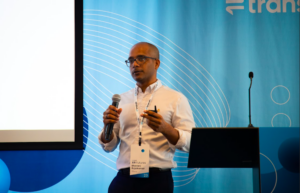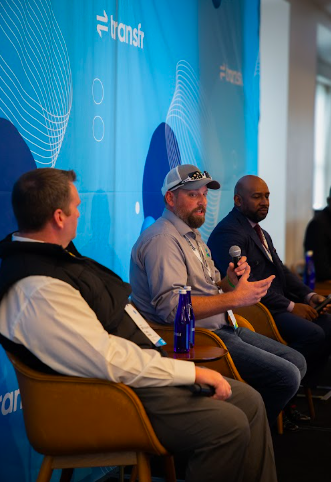AI isn’t the only acronym poised to create vast improvements in the way we teach and learn. Last month, eSchool attended “XR Training: The Next Frontier of Learning,” hosted by Transfr Inc. The event featured many speakers including CEO Bharani Rajakumar (pictured above), developers, and users in the corporate, not-for-profit, and government sectors that use simulation software to enhance job training programs.
Conversations touched on a wide variety of topics from the distinctions of spatial computing, to how XR can reduce the skills gap, to how its application can become a powerful force in underserved communities. It was a great opportunity to listen to some of the leading experts in the field, get our chance to try the gear firsthand and hear how the tech is already impacting lives. Scroll down for some highlights of the sessions and some examples of the simulations in action.
Extended reality (XR) is considered a catch-all term for augmented, virtual, and mixed reality technologies. The technology intends to combine or mirror the physical world with a “digital twin world” able to interact with it, which gives users an immersive experience by being in a virtual or augmented environment.
According to the US Bureau of Labor Statistics and the US Census Bureau, around 11 million people are either looking for a job or would look for one if they had the necessary skills. Transfr focuses on areas like construction, manufacturing, and healthcare, where almost 4 million job opportunities exist that don’t require a 4-year degree. The company believes in allowing everyone to pursue upward mobility by learning about their interests and acquiring the necessary skills.
The company has created over 300 training simulations, offering immersive experiences in aviation maintenance, diesel technology, and, more recently, healthcare. The introduction of Career Exploration 2.0 allows students to explore various career options through shorter, more engaging simulations, including new modules in health sciences and future occupations like electric vehicles and semiconductors. The platform has seen significant developments, including a new VR application for Career Exploration 2.0 with login options, diverse virtual coaches, multi-language support (including Spanish in 2024), closed captioning, and an enhanced dashboard for easier classroom management. Transfr has also launched a Career Exploration dashboard that helps instructors track students’ exploration paths and preferences, facilitating better guidance.
You can check out some of their simulation examples below:
I was able to grab Brian Bigelow, the marine manufacturing instructor at Arkansas State University to talk about their collaboration with Transfer VR and the use of virtual reality (VR) and augmented reality (AR) technologies in education, specifically in boat manufacturing. We focused on creating simulations (sims) for training students, enhancing engagement, and providing practical experiences in a controlled environment. Have a listen:
His pluses for the use of XR include:
Enhanced Learning Experience: The use of headsets allows students to actively engage in learning activities, making education more immersive and enjoyable. Brian emphasizes that students are often unaware they are learning, as the technology makes the educational experience so much fun.
Efficient Use of Resources: In a limited physical space, where only one student can use certain equipment at a time, VR and AR technologies allow others to remain engaged and learn outside the physical booth. This contributes to better time management and classroom efficiency.
Student Enthusiasm: Students are eager to use VR and AR technologies, often not wanting to take off the headsets.
Real-world Applications: Brian discusses the real-world applications of VR and AR, citing examples such as OSHA certification training and practical demonstrations of skills like using a fire extinguisher. He highlights the relevance of these skills to both professional and personal life.


